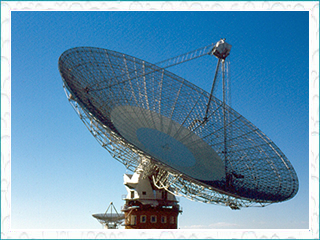Home > Maths in Action > Starting points > Pulsars in the mathematics classroom
Pulsars in the mathematics classroom
-
A pulsar is a rapidly rotating neutron star. Jets of electromagnetic radiation stream
from the pulsar and are observed as pulses
of radio waves because of this rotation. -
The 64 metre Parkes radio telescope was
built in 1961 and has operated continuously
for over 50 years. It is a world class instrument at the forefront of radio astronomy due to continual upgrades. It is now 10,000 times more sensitive than when it was first built. - The Parkes Radio telescope has been instrumental in discovering nearly two-thirds of all known pulsars
- Typical pulsar diameters are approximately 20 to 25 kilometres with a mass roughly 1.4 times the mass of the Sun. The mean density is approximately 6.7 x 1014 grams/cm3 which is equivalent to a single sugar cube weighing as much as all of humanity (approximately the weight of 7 billion people).
- CSIRO Australian radio-astronomer John O'Sullivan developed Wi-Fi as a by-product in a CSIRO research project. In April 2009, 14 technology companies agreed to pay CSIRO $250 million for infringements on CSIRO patents. CSIRO won a further $220 million settlement for Wi-Fi patent-infringements in 2012 with global firms in the United States required to pay the CSIRO licensing rights estimated to be worth an additional $1 billion in royalties
- Binary pulsars are used as a laboratory for testing Einstein’s general theory of relativity
- High school mathematics can be used to analyse pulsars. Formulas such as density = , volume = , surface area = 4, circumference = 2, speed = , frequency = , logs and ratio reveal a lot about the properties of pulsars
- Computer programs such as excel and other graphing software can be used to analyse the properties of 1,900 known pulsars
Activities associated with this Starting Point can be found in Resources section of the website:
- Pulsars Activities
- Pulsar Catalogue
- Magnetic Field of a Pulsar
- Density and Rotational Period of a Pulsar
[contributed by Stephen Broderick]
Lots of Pulsars
Try Wolfram Alpha to explore pulsars
Input
http://www.wolframalpha.com/input/?i=Pulsar
http://www.wolframalpha.com/input/?i=Binary+Pulsar
Interactive Demonstrations
http://www.demonstrations.wolfram.com/Pulsars/
http://www.demonstrations.wolfram.com/FittingAnEllipseToTheOrbitOfAStarNearTheGalacticCenter/
[contributed by Craig Bauling Wolfram Research, Inc]
|
|
Go to the Starting Points Forum to join the discussion or find more Starting Points |


